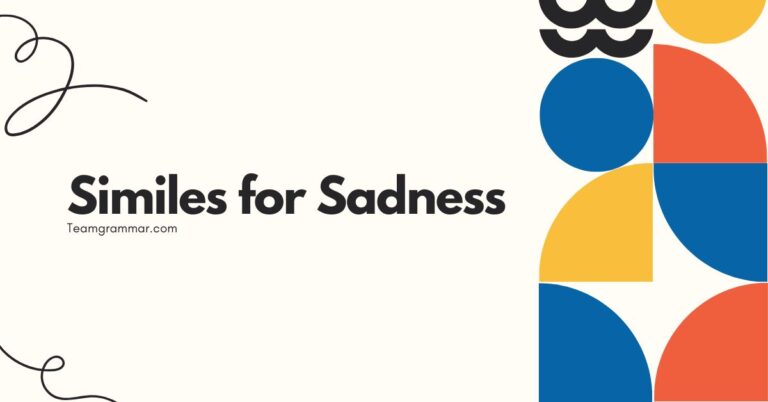37 Similes for Change: A Comprehensive Guide to Transformative Comparisons
Similes are powerful tools in the English language, allowing us to draw vivid comparisons and paint compelling pictures with our words. Understanding how to use similes effectively, particularly when discussing change, can significantly enhance your writing and communication skills.
This article delves into the nuances of similes, focusing on their application in describing transformations, evolutions, and shifts. Whether you’re a student, writer, or language enthusiast, this guide will equip you with the knowledge and practice needed to master the art of using similes to illustrate change.
Table of Contents
- Introduction
- Definition of Simile
- Structural Breakdown of Similes
- Types of Change Described by Similes
- Examples of Similes for Change
- Usage Rules for Similes
- Common Mistakes When Using Similes
- Practice Exercises
- Advanced Topics
- Frequently Asked Questions
- Conclusion
Definition of Simile
A simile is a figure of speech that compares two unlike things using the words “like” or “as.” Its primary function is to create a vivid image or emphasize a particular quality by drawing a parallel between the two subjects. Similes are essential tools in descriptive writing, poetry, and everyday conversation, allowing us to express ideas in a more engaging and understandable way.
The power of a simile lies in its ability to illuminate the unfamiliar by relating it to something familiar.
Similes are classified as figures of speech, specifically within the category of figurative language. They function to add color, depth, and nuance to our expressions.
The context in which similes are used can vary widely, ranging from formal literary works to casual conversations. Their effectiveness depends on the clarity of the comparison and the relevance of the shared quality between the two subjects.
Structural Breakdown of Similes
The basic structure of a simile involves three key components: the subject, the comparison word (“like” or “as”), and the object of comparison. Understanding these components is crucial for constructing effective and meaningful similes.
The subject is the thing being described, the comparison word establishes the link between the subject and the object, and the object provides a point of reference for understanding the subject.
The typical patterns for similes are:Subject + “like” + ObjectandSubject + “as” + Adjective + “as” + Object. For example, “He is as brave as a lion” follows the second pattern, while “Her smile is like sunshine” follows the first.
The adjective in the second pattern helps to further define the quality being compared. The choice between “like” and “as” often depends on the specific context and the desired emphasis.
Types of Change Described by Similes
Similes can be used to describe various types of change, each with its own distinct characteristics. These include gradual change, sudden change, positive change, negative change, and internal change.
Recognizing these different types of change allows for a more nuanced and precise use of similes.
- Gradual Change: Describes a slow, incremental transformation over time.
- Sudden Change: Describes an abrupt, immediate shift.
- Positive Change: Describes a beneficial or favorable transformation.
- Negative Change: Describes a detrimental or unfavorable transformation.
- Internal Change: Describes a change in one’s thoughts, feelings, or beliefs.
Examples of Similes for Change
The following sections provide extensive examples of similes used to describe different types of change. Each section includes a variety of similes, illustrating how they can be used in different contexts to convey different nuances of meaning.
Similes for Gradual Change
Gradual change is often described using similes that evoke a sense of slow, continuous progression. These similes help to illustrate how things evolve over time, often subtly and almost imperceptibly.
Here are some examples of similes that describe gradual change:
| Simile | Explanation |
|---|---|
| The seasons changed like the slow turning of a page. | Emphasizes the gradual and predictable nature of seasonal changes. |
| His hair turned gray like the gradual fading of a photograph. | Illustrates the slow and subtle process of aging. |
| The project progressed like a glacier moving down a mountain. | Highlights the slow but inexorable advance of a project. |
| Her understanding grew like a sapling reaching for the sun. | Illustrates the slow but continuous growth of understanding. |
| The relationship evolved like a seed sprouting into a tree. | Emphasizes the natural and gradual development of a relationship. |
| The city transformed like sand dunes shifting in the desert wind. | Illustrates the slow and continuous transformation of the city. |
| His attitude softened like ice melting in the spring sun. | Highlights the gradual softening of his attitude over time. |
| The economy recovered like a plant slowly growing back after a drought. | Emphasizes the slow and steady recovery of the economy. |
| The paint faded like colors bleeding into water. | Illustrates the gradual and subtle fading of the paint. |
| Her skills developed like a craftsman honing his trade. | Highlights the gradual and continuous development of her skills. |
| Their friendship deepened like roots intertwining beneath the soil. | Emphasizes the slow and continuous growth of their friendship. |
| The river carved its path like time etching lines on a face. | Illustrates the gradual and inexorable carving of the river’s path. |
| The language changed like a river meandering through the land. | Highlights the slow and natural evolution of the language. |
| His confidence grew like a flower slowly blooming in the sun. | Emphasizes the gradual and beautiful growth of his confidence. |
| The problem resolved itself like sediment settling at the bottom of a glass. | Illustrates the slow and natural resolution of the problem. |
| The story unfolded like a tapestry being slowly woven. | Highlights the gradual and intricate unfolding of the story. |
| The wound healed like a scar slowly fading with time. | Emphasizes the gradual and natural healing of the wound. |
| The understanding dawned like the slow rise of the morning sun. | Illustrates the gradual and illuminating dawn of understanding. |
| The tension eased like a knot slowly untangling. | Highlights the gradual and relieving easing of the tension. |
| His wisdom grew like rings forming in a tree trunk. | Emphasizes the gradual and cumulative growth of his wisdom. |
| The project evolved like a caterpillar transforming into a butterfly. | Illustrates the slow and beautiful evolution of the project. |
| Her knowledge expanded like ripples spreading across a pond. | Highlights the gradual and expansive growth of her knowledge. |
| The culture shifted like the slow drift of tectonic plates. | Emphasizes the gradual and powerful shift of the culture. |
| Their love blossomed like a vine slowly climbing a wall. | Illustrates the gradual and beautiful blossoming of their love. |
| The conflict subsided like embers slowly cooling in the hearth. | Highlights the gradual and relieving subsidence of the conflict. |
Similes for Sudden Change
Sudden change is best described using similes that evoke a sense of immediacy and unexpectedness. These similes often involve imagery of rapid movements, abrupt shifts, or shocking events.
Here are some examples of similes for sudden change:
| Simile | Explanation |
|---|---|
| The storm arrived like a thief in the night. | Emphasizes the sudden and unexpected arrival of the storm. |
| Her mood shifted like a switch being flipped. | Illustrates the abrupt and immediate change in her mood. |
| The news hit him like a bolt of lightning. | Highlights the shocking and sudden impact of the news. |
| The market crashed like a house of cards collapsing. | Illustrates the sudden and complete collapse of the market. |
| His anger erupted like a volcano. | Emphasizes the sudden and intense outburst of his anger. |
| The opportunity vanished like a puff of smoke. | Illustrates the sudden and complete disappearance of the opportunity. |
| Her tears flowed like a dam bursting. | Highlights the sudden and uncontrollable flow of her tears. |
| The earthquake struck like a giant’s fist slamming the earth. | Emphasizes the sudden and devastating impact of the earthquake. |
| The truth revealed itself like a curtain being pulled back. | Illustrates the sudden and complete revelation of the truth. |
| His career took off like a rocket. | Highlights the sudden and rapid ascent of his career. |
| The argument escalated like a wildfire spreading through dry grass. | Emphasizes the sudden and rapid escalation of the argument. |
| The power went out like someone flicking a switch. | Illustrates the sudden and complete loss of power. |
| Her fear surged like a tidal wave. | Highlights the sudden and overwhelming surge of her fear. |
| The answer came to him like a flash of inspiration. | Emphasizes the sudden and illuminating arrival of the answer. |
| The accident happened like a blink of an eye. | Illustrates the sudden and instantaneous occurrence of the accident. |
| His hope was extinguished like a candle blown out by the wind. | Highlights the sudden and complete extinguishing of his hope. |
| The war began like a sudden clap of thunder. | Emphasizes the sudden and shocking beginning of the war. |
| Her heart stopped like a clock suddenly ceasing to tick. | Illustrates the sudden and complete ceasing of her heart’s function. |
| The secret was exposed like a wound suddenly opened. | Highlights the sudden and shocking exposure of the secret. |
| His fortune changed like a lottery ticket being drawn. | Emphasizes the sudden and unexpected change in his fortune. |
| The building collapsed like a sandcastle being washed away by the tide. | Illustrates the sudden and complete collapse of the building. |
| Her confidence shattered like glass. | Highlights the sudden and complete shattering of her confidence. |
| The revolution erupted like a long-dormant volcano. | Emphasizes the sudden and explosive eruption of the revolution. |
| His dreams were crushed like a bug underfoot. | Illustrates the sudden and complete crushing of his dreams. |
| The silence broke like a pane of glass shattering. | Highlights the sudden and jarring breaking of the silence. |
Similes for Positive Change
Positive change is often described using similes that evoke a sense of growth, improvement, and hope. These similes help to illustrate the beneficial and favorable aspects of transformation.
Here are some examples of similes for positive change:
| Simile | Explanation |
|---|---|
| Her spirit soared like a bird released from its cage. | Emphasizes the uplifting and liberating nature of the change. |
| His health improved like a garden flourishing after rain. | Illustrates the revitalizing and restorative effect of the change. |
| Her confidence blossomed like a flower in spring. | Highlights the beautiful and natural growth of her confidence. |
| The community thrived like a forest ecosystem after a fire. | Illustrates the resilient and vibrant thriving of the community. |
| His life transformed like a caterpillar turning into a butterfly. | Emphasizes the beautiful and complete transformation of his life. |
| The relationship healed like a broken bone mending. | Illustrates the strong and complete healing of the relationship. |
| Her outlook brightened like the sun breaking through the clouds. | Highlights the illuminating and positive brightening of her outlook. |
| The economy recovered like a patient regaining strength. | Emphasizes the strong and steady recovery of the economy. |
| His creativity flowed like a river after a dam was removed. | Illustrates the abundant and unrestricted flow of his creativity. |
| Her potential unfolded like the petals of a lotus. | Highlights the beautiful and complete unfolding of her potential. |
| The project succeeded like a well-oiled machine. | Emphasizes the smooth and efficient success of the project. |
| His happiness grew like a tree bearing fruit. | Illustrates the abundant and rewarding growth of his happiness. |
| Her understanding deepened like a well filling with water. | Highlights the profound and enriching deepening of her understanding. |
| The team worked together like a symphony orchestra. | Emphasizes the harmonious and effective collaboration of the team. |
| His spirit lifted like a balloon rising into the sky. | Illustrates the uplifting and liberating lifting of his spirit. |
| The company prospered like a seed planted in fertile soil. | Highlights the abundant and sustainable prospering of the company. |
| Her dreams took flight like birds soaring on the wind. | Emphasizes the free and fulfilling taking flight of her dreams. |
| His wisdom shone like a beacon in the darkness. | Illustrates the guiding and illuminating shining of his wisdom. |
| The future looked bright like a sunrise on a clear morning. | Highlights the promising and hopeful brightness of the future. |
| Her love grew like a garden nurtured with care. | Emphasizes the beautiful and flourishing growth of her love. |
| The organization evolved like a chrysalis transforming into a butterfly. | Illustrates the beautiful and complete evolution of the organization. |
| His heart opened like a flower unfolding to the sun. | Highlights the beautiful and welcoming opening of his heart. |
| The situation improved like a ship righting itself after a storm. | Emphasizes the stable and reassuring improvement of the situation. |
| Her life blossomed like a rose in full bloom. | Illustrates the beautiful and complete blossoming of her life. |
| His journey progressed like a river flowing towards the sea. | Highlights the steady and purposeful progress of his journey. |
Similes for Negative Change
Negative change is often described using similes that evoke a sense of decline, deterioration, and despair. These similes help to illustrate the detrimental and unfavorable aspects of transformation.
| Simile | Explanation |
|---|---|
| His health deteriorated like a building crumbling to dust. | Emphasizes the severe and irreversible deterioration of his health. |
| Her hope faded like a dying ember. | Illustrates the weak and vanishing state of her hope. |
| The relationship soured like milk left out in the sun. | Highlights the unpleasant and spoiled state of the relationship. |
| The city decayed like a ghost town abandoned to the elements. | Illustrates the desolate and decaying state of the city. |
| His dreams shattered like glass falling on concrete. | Emphasizes the complete and irreparable shattering of his dreams. |
| Her spirit withered like a flower without water. | Illustrates the weakened and lifeless state of her spirit. |
| The economy collapsed like a house of cards. | Highlights the sudden and complete collapse of the economy. |
| His confidence eroded like a coastline battered by waves. | Emphasizes the gradual but relentless erosion of his confidence. |
| Her smile disappeared like a shadow in the night. | Illustrates the sudden and complete disappearance of her smile. |
| The situation worsened like a disease spreading through a population. | Highlights the severe and uncontrolled worsening of the situation. |
| His reputation was tarnished like silver exposed to air. | Emphasizes the discolored and damaged state of his reputation. |
| Her love died like a fire starved of oxygen. | Illustrates the extinguished and lifeless state of her love. |
| The project failed like a ship sinking in a storm. | Highlights the complete and disastrous failure of the project. |
| His heart broke like a vase dropped on the floor. | Emphasizes the painful and irreparable breaking of his heart. |
| The trust was betrayed like a knife in the back. | Illustrates the painful and treacherous betrayal of the trust. |
| Her innocence was lost like a pearl cast into the sea. | Highlights the irretrievable and precious loss of her innocence. |
| The world darkened like a solar eclipse. | Emphasizes the ominous and complete darkening of the world. |
| His hope was crushed like a flower stepped on. | Illustrates the brutal and complete crushing of his hope. |
| The future looked bleak like a winter landscape. | Highlights the desolate and hopeless bleakness of the future. |
| Her joy vanished like a dream upon waking. | Emphasizes the sudden and complete vanishing of her joy. |
| The community declined like a tree rotting from the inside. | Illustrates the gradual and destructive decline of the community. |
| His spirit broke like a twig snapping in the wind. | Highlights the sudden and complete breaking of his spirit. |
| The promise was broken like a vow made in jest. | Emphasizes the disregarded and meaningless breaking of the promise. |
| Her faith crumbled like sandcastles before the tide. | Illustrates the weak and collapsing state of her faith. |
| His life unraveled like a thread pulled from a sweater. | Highlights the gradual and destructive unraveling of his life. |
Similes for Internal Change
Internal change refers to changes in one’s thoughts, feelings, beliefs, or character. Similes that describe internal change often evoke a sense of introspection, self-discovery, and personal growth.
| Simile | Explanation |
|---|---|
| His perspective shifted like a kaleidoscope turning. | Emphasizes the varied and transformative nature of his perspective shift. |
| Her understanding deepened like a well filling with wisdom. | Illustrates the profound and enriching deepening of her understanding. |
| His heart softened like ice melting in the spring sun. | Highlights the gentle and gradual softening of his heart. |
| Her beliefs solidified like concrete setting. | Illustrates the firm and unwavering solidification of her beliefs. |
| His resolve strengthened like steel being forged in fire. | Emphasizes the tough and resilient strengthening of his resolve. |
| Her compassion grew like a vine climbing a wall. | Illustrates the expansive and nurturing growth of her compassion. |
| His self-awareness dawned like the sun rising. | Highlights the illuminating and gradual dawning of his self-awareness. |
| Her inner peace settled like snow falling softly. | Emphasizes the calm and gentle settling of her inner peace. |
| His courage emerged like a flower pushing through concrete. | Illustrates the strong and determined emergence of his courage. |
| Her values clarified like a diamond being cut. | Highlights the precise and refined clarification of her values. |
| His conscience pricked him like a thorn. | Emphasizes the sharp and uncomfortable pricking of his conscience. |
| Her empathy expanded like ripples spreading across a pond. | Illustrates the broad and encompassing expansion of her empathy. |
| His self-confidence grew like a tree putting down roots. | Highlights the strong and stable growth of his self-confidence. |
| Her wisdom accumulated like rings in a tree trunk. | Emphasizes the cumulative and enriching accumulation of her wisdom. |
| His character developed like a photograph being revealed in a darkroom. | Illustrates the gradual and clear development of his character. |
| Her inner strength blossomed like a desert flower. | Highlights the resilient and beautiful blossoming of her inner strength. |
| His spirit transformed like a caterpillar becoming a butterfly. | Emphasizes the complete and beautiful transformation of his spirit. |
| Her understanding unfolded like a map being revealed. | Illustrates the gradual and comprehensive unfolding of her understanding. |
| His heart opened like a door welcoming a stranger. | Highlights the generous and welcoming opening of his heart. |
| Her soul awakened like a sleeping giant. | Emphasizes the powerful and complete awakening of her soul. |
| His mind cleared like fog lifting in the morning. | Illustrates the clear and refreshing lifting of the fog in his mind. |
| Her thoughts aligned like stars coming into constellation. | Highlights the harmonious and meaningful alignment of her thoughts. |
| His beliefs evolved like a river changing course. | Emphasizes the natural and transformative evolution of his beliefs. |
| Her emotions settled like dust in a quiet room. | Illustrates the calm and peaceful settling of her emotions. |
| His identity crystallized like a snowflake forming. | Highlights the unique and intricate crystallization of his identity. |
Usage Rules for Similes
Using similes effectively requires adhering to certain rules to ensure clarity and impact. One of the most important rules is to ensure that the comparison is logical and relevant.
The two things being compared should share a common quality that is easily understood by the reader or listener. Avoid comparisons that are too obscure or far-fetched, as they can confuse or distract the audience.
Another important rule is to avoid clichés. Overused similes, such as “as busy as a bee” or “as strong as an ox,” have lost their impact and can make your writing sound unoriginal.
Instead, strive to create fresh and imaginative comparisons that will capture the reader’s attention. Consider the context in which you are using the simile and tailor it to the specific situation.
Also, maintain consistency in your writing style. If you are writing in a formal tone, avoid using overly casual or colloquial similes.
Conversely, if you are writing in an informal tone, avoid using similes that are too elaborate or academic. The key is to ensure that your similes complement your overall writing style and enhance the message you are trying to convey.
Common Mistakes When Using Similes
One of the most common mistakes when using similes is confusing them with metaphors. While both similes and metaphors are figures of speech that compare two unlike things, similes use the words “like” or “as” to make the comparison explicit, while metaphors imply the comparison without using these words.
For example, “He is like a lion” is a simile, while “He is a lion” is a metaphor.
Another common mistake is creating illogical or nonsensical comparisons. For example, “The sky is like a refrigerator” is not an effective simile because there is no clear or logical connection between the sky and a refrigerator.
An effective simile should draw a clear and meaningful comparison between the two subjects.
Finally, overuse of similes can also weaken their impact. While similes can be powerful tools, using too many of them in a single piece of writing can make your writing sound contrived and unnatural.
Use similes sparingly and strategically, choosing them carefully to highlight the most important qualities or ideas you want to emphasize.
Here are some examples of correct vs. incorrect simile usage:
| Incorrect | Correct | Explanation |
|---|---|---|
| The car was like a thought. | The car was like a bullet, speeding down the highway. | The incorrect simile lacks a clear connection between the car and a thought. The correct simile provides a specific and understandable comparison. |
| He was as good as anything. | He was as good as gold, always reliable and dependable. | The incorrect simile is vague and meaningless. The correct simile uses a specific and recognizable comparison. |
| Her smile was like a rock. | Her smile was like sunshine, warming everyone around her. | The incorrect simile creates a confusing and negative image. The correct simile creates a positive and uplifting image. |
| The book was as tall as a feeling. | The book was as tall as a skyscraper, towering over the city. | The incorrect simile is abstract and nonsensical. The correct simile uses a concrete and measurable comparison. |
Practice Exercises
Complete the following sentences by adding a simile that describes the type of change indicated in parentheses.
- The weather changed __________________________ (sudden change).
- Her attitude improved __________________________ (positive change).
- The old building deteriorated __________________________ (negative change).
- His understanding grew __________________________ (gradual change).
- Her perspective shifted __________________________ (internal change).
- The argument escalated __________________________ (sudden change).
- The community thrived __________________________ (positive change).
- His health declined __________________________ (negative change).
- Her knowledge expanded __________________________ (gradual change).
- His compassion deepened __________________________ (internal change).
Answers:
- The weather changed like a light switch being flipped (sudden change).
- Her attitude improved like a garden flourishing after rain (positive change).
- The old building deteriorated like a sandcastle being washed away by the tide (negative change).
- His understanding grew like a tree putting down roots (gradual change).
- Her perspective shifted like a kaleidoscope turning (internal change).
- The argument escalated like a wildfire spreading through dry grass (sudden change).
- The community thrived like a forest ecosystem after a fire (positive change).
- His health declined like a building crumbling to dust (negative change).
- Her knowledge expanded like ripples spreading across a pond (gradual change).
- His compassion deepened like a well filling with wisdom (internal change).
Rewrite the following sentences, replacing the underlined phrases with similes.
- The storm was very destructive.
- Her joy disappeared quickly.
- His anger grew intensely.
- The company succeeded greatly.
- Her fear was overwhelming.
Answers:
- The storm was like a raging beast, tearing through the town.
- Her joy disappeared like a puff of smoke in the wind.
- His anger grew like a volcano erupting.
- The company succeeded like a rocket soaring into space.
- Her fear was like a tidal wave, crashing over her.
Advanced Topics
For advanced learners, exploring the use of extended similes can add depth and complexity to their writing. An extended simile is a simile that is developed over several sentences or even paragraphs, allowing for a more detailed and nuanced comparison.
This technique can be particularly effective in literary writing, where it can be used to create vivid imagery and explore complex themes.
Another advanced topic is the use of similes in different genres of writing. While similes are commonly used in poetry and fiction, they can also be used effectively in nonfiction writing, such as essays, articles, and speeches.
However, the specific types of similes that are appropriate for each genre may vary. For example, formal essays may require more sophisticated and academic similes, while informal speeches may allow for more casual and colloquial comparisons.
Finally, advanced learners can also explore the use of similes in different cultures and languages. The specific types of comparisons that are considered effective or appropriate may vary across cultures, and understanding these differences can help to improve cross-cultural communication.
Additionally, studying similes in different languages can provide insights into the unique ways that different cultures perceive and understand the world.
Frequently Asked Questions
- What is the difference between a simile and a metaphor?
A simile is a comparison using “like” or “as,” while a metaphor implies a comparison without these words. For example, “He is like a lion” (simile) vs. “He is a lion” (metaphor).
- How can I avoid using clichés in my similes?
Strive for originality by thinking beyond common comparisons. Consider the specific qualities you want to emphasize and create fresh, imaginative similes that capture those qualities in a unique way. Brainstorm different ideas and experiment with unexpected combinations to avoid overused phrases.
- Can similes be used in formal writing?
Yes, but use them judiciously. Choose sophisticated and precise comparisons that enhance your argument without sounding too informal or colloquial. Ensure the similes are relevant to the topic and contribute to the overall tone of the writing.
- What are some common mistakes to avoid when using similes?
Avoid clichés, illogical comparisons, and overuse. Ensure your similes are clear, relevant, and contribute to the overall meaning of your writing. Also, avoid mixing similes and metaphors unintentionally, as this can create confusing or nonsensical imagery.
- How can I make my similes more impactful?
Use vivid and sensory language to create a clear and memorable image. Consider the emotional impact of your simile and choose comparisons that evoke the desired feeling in your reader. Also, ensure your similes are original and tailored to the specific context of your writing.
- Are there any specific types of change that are best described using similes?
Similes are effective for describing gradual, sudden, positive, negative, and internal changes. The key is to choose similes that accurately reflect the nature of the change and evoke the desired emotional response.
- How do extended similes enhance writing?
Extended similes allow for a more detailed and nuanced comparison, creating a richer and more vivid image in the reader’s mind. This technique is particularly effective for exploring complex themes and adding depth to literary writing.







